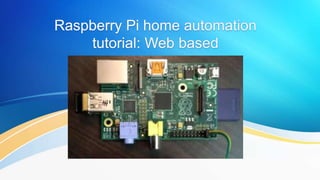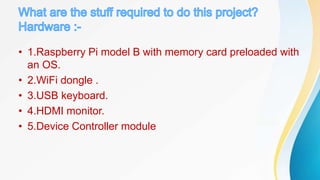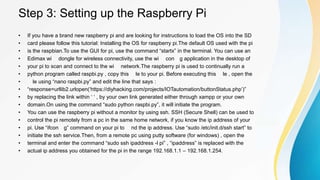Raspberry pi home automation idea
- 2. ŌĆó It is a concept where devices in our home or wherever they are , have the capability to communicate with each other via the internet web based using normal HTTP protocols , you will be able to control any appliance in your home from anywhere.
- 3. ŌĆó 1.Raspberry Pi model B with memory card preloaded with an OS. ŌĆó 2.WiFi dongle . ŌĆó 3.USB keyboard. ŌĆó 4.HDMI monitor. ŌĆó 5.Device Controller module
- 4. ŌĆó 1.PHP. ŌĆó 2.HTML/CSS. ŌĆó 3.Python. ŌĆó 4.Linux/Rasbian.
- 6. Here,the server is the web interface consisting of buttons and UI (User Interface) that will allow you to turn ON/OFF a device. It consists of PHP files, Html files and a .txt file (to store data). The server usually stores information regarding the button press on the page (ON/OFF) on a .txt file.
- 7. ŌĆó his is a simple Html file called main.html ,consisting of two buttons. ŌĆó The clicking of the buttons will trigger the execution of a PHP file called button.php. ŌĆó This program serves as an API (Application Programming Interface) to store data on to a text file called button Status.txt. ŌĆó The data is a string : ŌĆ£ONŌĆØ, if ON button is clicked and ŌĆ£OFFŌĆØ, if OFF button is clicked. ŌĆó Thus the current button press state is recorded in the text file : buttonStatus.txt.
- 8. ’ā╝ The client side consists of a Raspberry Pi with a relay circuit connected to its GPIO pin. ’ā╝ The pi runs a python program which is used to ŌĆśPostŌĆÖ a url link using urllib2. ’ā╝ That is, the pi constantly reads the contents of a url link. ’ā╝ Here, the url link is another PHP file called buttonStatus.php ’ā╝ This PHP file serves as an API to read the contents of the text file buttonStatus.txt ’ā╝ After reading the data, the python program checks if the string obtained is ŌĆ£ONŌĆØ / ŌĆ£OFFŌĆØ based on which it switches ON/OFF the relay respectively via its GPIO pin.
- 9. ŌĆó Step 1: Preparing the html, php files ŌĆó Step 2: Setting up the relay circuit for the Raspberry Pi home automation system ŌĆó Step 3: Setting up the Raspberry Pi
- 10. ŌĆó Here, the server side of the system has to be set up. If you are having your own domain, you ŌĆó can use the file manager service to drop these files into your server and can be used to control ŌĆó your IoT systems from anywhere around the world. The files to be put in your server are : ŌĆó main.html , button.php , buttonStatus.php and buttonStatus.txt , download them from here : ŌĆó DIY Hacking ŌĆō Raspberry Pi home automation system and extract it. The program raspbi.py is ŌĆó the python program which is to be copied to your raspberry pi.If you are new to html and php , ŌĆó donŌĆÖt worry. This project will need only a basic understanding of the two languages, spending ŌĆó some time on a few tutorials :HTML for beginners , PHP for beginners and reading the code ŌĆó would be su cient. The html file consists of a basic UI with two buttons. On button press, it ŌĆó triggers a PHP program which writes a string to a .txt files depending on the button pressed.The ŌĆó .txt le stores information of the last button state. ŌĆó However, if you donŌĆÖt have a domain, you can simulate a domain in your local network or wi ŌĆó using a service called xampp. It is very simple, the instructions for using it are here : Xampp Web ŌĆó Server Emulator Windows and Xampp Web Server Emulator Linux. Using xampp you can useyour ŌĆó pc as a local web server. However, the IoT systems gets con ned to a control range limited ŌĆó to your home wi network. Drop the html, php and .txt les into the /htdocs/xampp directory.
- 11. Step 2: Setting up the relay circuit for the Raspberry Pi home automation system ŌĆó A small relay circuit is to be made , to switch an appliance ON/OFF
- 12. Step 3: Setting up the Raspberry Pi ŌĆó If you have a brand new raspberry pi and are looking for instructions to load the OS into the SD ŌĆó card please follow this tutorial: Installing the OS for raspberry pi.The default OS used with the pi ŌĆó is the raspbian.To use the GUI for pi, use the command ŌĆ£startxŌĆØ in the terminal. You can use an ŌĆó Edimax wi dongle for wireless connectivity, use the wi con g application in the desktop of ŌĆó your pi to scan and connect to the wi network.The raspberry pi is used to continually run a ŌĆó python program called raspbi.py , copy this le to your pi. Before executing this le , open the ŌĆó le using ŌĆ£nano raspbi.pyŌĆØ and edit the line that says : ŌĆó ŌĆ£response=urllib2.urlopen(ŌĆśhttps://diyhacking.com/projects/IOTautomation/buttonStatus.phpŌĆÖ)ŌĆØ ŌĆó by replacing the link within ŌĆś ŌĆś , by your own link generated either through xampp or your own ŌĆó domain.On using the command ŌĆ£sudo python raspbi.pyŌĆØ, it will initiate the program. ŌĆó You can use the raspberry pi without a monitor by using ssh. SSH (Secure Shell) can be used to ŌĆó control the pi remotely from a pc in the same home network, if you know the ip address of your ŌĆó pi. Use ŌĆ£ifcon gŌĆØ command on your pi to nd the ip address. Use ŌĆ£sudo /etc/init.d/ssh startŌĆØ to ŌĆó initiate the ssh service.Then, from a remote pc using putty software (for windows) , open the ŌĆó terminal and enter the command ŌĆ£sudo ssh ipaddress -l piŌĆØ , ŌĆ£ipaddressŌĆØ is replaced with the ŌĆó actual ip address you obtained for the pi in the range 192.168.1.1 ŌĆō 192.168.1.254.
- 13. ŌĆó Connect the relay circuit to the raspberry pi. You need to connect GPIO pin no : 5 and 6 (GND) to ŌĆó the circuit as in the schematic. Please note: Raspberry pi uses GPIO pins 5 and 6 to get into safe ŌĆó mode by shorting them together. Hence, please use any other GPIO other than 5 by editing the ŌĆó python program, to prevent booting into the safe mode












